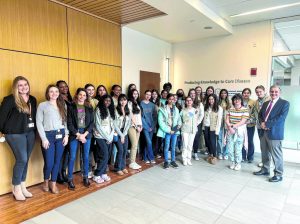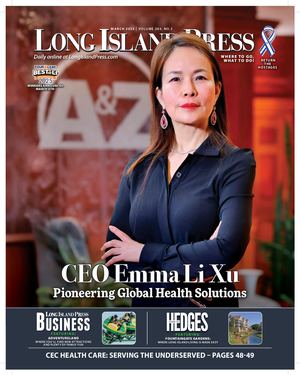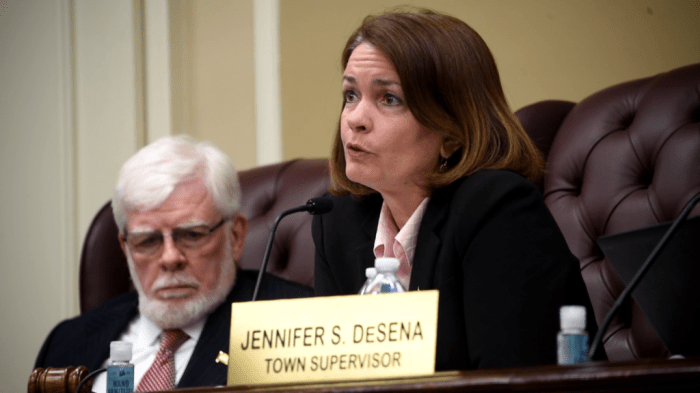 For many people, the only time the Girl Scouts come up in conversation is during “Cookie Season.” But the Girl Scouts are active all year round, teaching girls how to engage with the world and make a difference. Shortly after International Day of Women and Girls in Science, Girl Scouts of Nassau County brought 23 girls from various troops across Nassau to the Feinstein Institutes for Medical Research to learn about the women of Advancing Women in Science and Medicine, or AWSM (pronounced ‘awesome’). This all-female research group led them on a tour of the facility and also gave a series of inspiring lectures. They also observed lab demonstrations and participated in discussions with the faculty about women in the still male-dominated STEM (Science, Technology, Engineering and Math) careers. The attending Girl Scouts who are in high school also learned how to apply for a paid internship with the Feinstein Institutes and research a topic of their choice.
For many people, the only time the Girl Scouts come up in conversation is during “Cookie Season.” But the Girl Scouts are active all year round, teaching girls how to engage with the world and make a difference. Shortly after International Day of Women and Girls in Science, Girl Scouts of Nassau County brought 23 girls from various troops across Nassau to the Feinstein Institutes for Medical Research to learn about the women of Advancing Women in Science and Medicine, or AWSM (pronounced ‘awesome’). This all-female research group led them on a tour of the facility and also gave a series of inspiring lectures. They also observed lab demonstrations and participated in discussions with the faculty about women in the still male-dominated STEM (Science, Technology, Engineering and Math) careers. The attending Girl Scouts who are in high school also learned how to apply for a paid internship with the Feinstein Institutes and research a topic of their choice.
Girl Scouts in the United States grew out of the Boy Scouts and Girl Guides of Britain. In 1912, inspired by a meeting with the founder of the boy scouts, Juliette Gordon Low created an organization based on the same principles. Before women even had the right to vote, the Girl Scouts emphasized inclusiveness, the outdoors, self-reliance, and service. In the 1930s, Girl Scouts collected relief supplies during the Depression and printed their promotional booklet in multiple languages. Throughout the ‘40s and ‘50s, they supported the war efforts by growing Victory Gardens and gathering supplies for Korean families called “Kits for Korea.” In the 1960s they held “Speak Out” conferences in support of racial equality and launched the “Action 70” project to help people overcome prejudice. The ‘70s saw the Girl Scouts join the burgeoning environmental movement and also elect their first black national board president, Gloria D. Scott. Over the next 30 years, they took on issues like drug abuse and teen pregnancy, jumped feet first into the early days of the internet and elected Patricia Diaz Dennis, their first Latina as chair of the National Board.
Dr. Betty Diamond, director of the Institute of Molecular Medicine at the Feinstein Institutes, formed AWSM in 2010 to help advance career opportunities for women at the Feinstein Institutes. She spoke with Girl Scouts about the group’s programs in basic, translational and clinical research and its initiatives in recognition, career development, advocacy, education, networking and mentoring.
“We know that women in science and medicine continue to face challenges due to gender bias,” said Dr. Diamond. “One of my goals through AWSM is to help empower women of all ages to become interested in and succeed at STEM. The group of Girl Scouts who visited The Feinstein Institutes are the next generation of women scientists who will prove again that women belong in STEM.”
One of the women who interacted with the girls was Dr. Lior Brimberg, assistant professor at the Feinstein Institutes for Medical Research and co-president of AWSM. She emphasized the part a female role model can play in empowering young women to follow their dreams. “I have to say I was really lucky to have really fantastic role models and mentors during my career, graduate school and my postdoc fellowship. I’m sure that made a big difference for me. I think role models are very important, especially for women and for women scientists. So I was really lucky, to have wonderful female role models and mentors, and I’m really lucky to be part of the Feinstein, where we have such a group.”
While awareness is greater now, STEM fields are still mostly filled by men, especially in the more prestigious roles, Brimberg said. “There has been a lot of effort to narrow the gender gap between males and females in STEM careers in general. (but) even with that, we know, especially within the top echelon, women are (under) represented.”
This makes it critical for women to step up and increase representation, because having more women in the field will encourage more women to choose those career paths, creating an exponential increase in support. Brimberg had some simple advice for girls who are interested in STEM. “Always follow your heart, follow your curiosity, and just do it. Maybe social or cultural factors do come into play (to discourage girls) but I think the most important (factor) is role models in STEM. I think that’s what can drive everything forward.”
Through programs like “Women and Girls in Science,” Girl Scouts continue to champion and empower girls. Whether they have an interest in STEM careers or are just curious about how things work, it is important to give young women the opportunity to explore. So many of the concepts used in STEM careers can be applied to everyday life. According to Girl Scouts’ developmental psychologist Dr. Andrea Bastiani Archibald, “not every girl is going to want to pursue a career in STEM, and it’s important to encourage her to follow her own passions, but every girl should be encouraged to try her hand at STEM skills, get comfortable with those concepts, and learn how they apply to all kinds of surprising fields—from fashion to finance, and beyond.”
In addition to its partnership with the Feinstein Institutes, the Girl Scouts of Nassau County helps girls explore a range of career paths through programs like “A Day in the Life of a Reporter,” “Law Experience Day” in partnership with the Hofstra University School of Law and “Writing for Digital Publications” in partnership with Her Campus.































